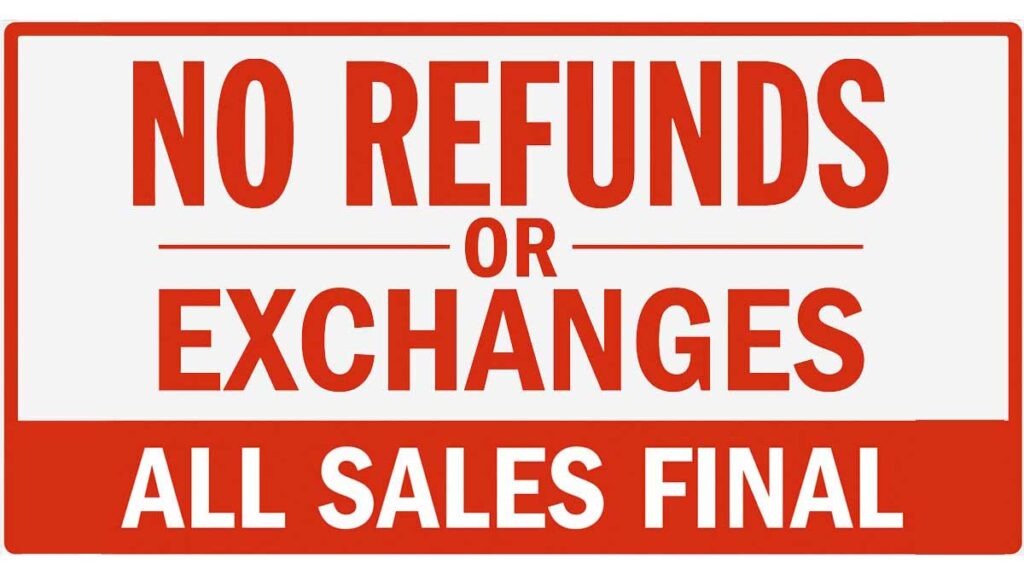Are you a beginner in online shopping? Have you ever wondered what happens if you need to return a product? Look no further! In this article, you will gain a comprehensive understanding of return regulations and how they work. We will break down the basics and provide you with valuable insights, allowing you to navigate the world of returns with confidence. Whether it’s a wrong size or a faulty item, we’ve got you covered. Get ready to unravel the mysteries of return policies and make future online shopping experiences hassle-free!
Part 1: Introduction to Return Regulations
What are return regulations?
Return regulations refer to the rules and policies set by retailers and governments regarding the return of products purchased by customers. These regulations outline the conditions, procedures, and rights associated with returning an item for various reasons, such as dissatisfaction, damaged goods, or incorrect orders.
Understanding return regulations is essential for both consumers and businesses. For consumers, it ensures that they are aware of their rights and options when it comes to returning a product. For businesses, it helps them establish fair and feasible return policies that balance customer satisfaction with operational efficiency.
Importance of understanding return regulations
As a consumer, having a clear understanding of return regulations allows you to make informed purchasing decisions. It provides you with peace of mind, knowing that if you encounter any issues with your purchase, you have the right to return it within certain parameters. This understanding empowers you to confidently engage in transactions and choose retailers who prioritize customer satisfaction.
For businesses, understanding return regulations is crucial for building trust and maintaining good customer relationships. By implementing clear and fair return policies, businesses demonstrate their commitment to customer satisfaction and are more likely to create loyal customers. Additionally, complying with return regulations helps businesses avoid legal issues and potential damage to their reputation.
Part 2: Types of Return Regulations
Return policies of online retailers
Online retailers often have specific return policies due to the nature of their business. These policies typically include details about the timeframe for returns, condition requirements, and the process for initiating a return. Online retailers may also offer free return shipping or provide prepaid return labels to make the process more convenient for customers.
Return policies of brick-and-mortar stores
Brick-and-mortar stores, on the other hand, may have different return policies that take into account the in-person shopping experience. These policies often specify whether returns can be made in-store or through mail, as well as any requirements for presenting a receipt or proof of purchase. Some stores may also offer store credit instead of cash refunds for returned items.
Return policies of specific industries
Certain industries may have unique return policies due to the nature of their products. For example, electronics retailers may have stricter return policies due to concerns about warranty fraud or misuse of products. Apparel retailers may have specific guidelines for returning intimate items such as underwear or swimwear. Understanding the return policies of specific industries is crucial to ensure a smooth return process.
Part 3: Common Conditions for Returns
Timeframe for returning a product
Return regulations often establish a timeframe within which a product can be returned. This timeframe varies depending on the retailer and the type of product. It is important to review the return policy of each retailer before making a purchase to ensure that the timeframe aligns with your needs. Keep in mind that some retailers offer extended return periods during holiday seasons.
Product condition for returns
Return regulations generally require products to be returned in an acceptable condition. This means that the item should be unopened, unused, and in its original packaging, unless specified otherwise. Products that have been damaged, altered, or show signs of wear and tear may not be eligible for a refund or exchange. It is crucial to carefully review the condition requirements stated in the return policy to avoid any complications.
Return packaging and labeling requirements
In some cases, return regulations may require specific packaging and labeling for returned items. This ensures that the product reaches the retailer in a proper condition and facilitates the processing of returns. Common requirements include using the original packaging, including all accessories and manuals, and attaching the provided return label or tracking number. Failure to comply with packaging and labeling requirements may result in delays or denial of the return.
Part 4: Return Methods
In-store returns
For purchases made in physical stores, in-store returns are a convenient option. This method allows you to bring the item back to the store and complete the return process in person. In-store returns typically require presenting the original receipt or proof of purchase. Some retailers may offer instant refunds, while others may process the refund within a specified period.
Mail returns
Mail returns are commonly used for online purchases or when returning items to retailers that offer this option. To initiate a mail return, you typically need to contact the retailer, request a return authorization, and follow their instructions for packaging and shipping the item. It is important to retain proof of postage and consider purchasing insurance or using a trackable shipping method for valuable items.
Drop-off returns
Certain retailers and delivery services may offer drop-off returns as a convenient alternative to in-store or mail returns. Drop-off locations, such as postal offices or designated drop-off points, allow you to return the item without the hassle of packaging and shipping it yourself. This method can save time and effort, especially for larger or heavy items.
Online returns
To cater to the digital age, many retailers now offer online returns through their websites or mobile apps. This method involves initiating a return request online, providing necessary information about the product and reason for return, and receiving shipping instructions or labels via email. Online returns offer convenience and allow you to complete the process without leaving your home.
Part 5: Understanding Return Fees and Refunds
Restocking fees
Some retailers may charge restocking fees for returns, especially for certain products or in specific circumstances. Restocking fees are typically a percentage of the item’s original purchase price and are meant to cover the costs associated with inspecting, repackaging, and restocking returned items. It is important to review the return policy to see if restocking fees apply and factor them into your decision-making process.
Shipping fees
Return regulations may specify whether customers are responsible for covering the shipping fees associated with returning a product. Some retailers offer free return shipping, while others require customers to bear the cost. Understanding the shipping fees involved in the return process helps you make informed decisions and avoid unexpected expenses.
Refund options
Return regulations usually outline the available refund options for returned items. Common options include cash refunds, store credit, or exchanges for a different item. Cash refunds are typically the preferred choice for customers, as they provide the full reimbursement of the purchase price. Store credit can be convenient if you plan to make future purchases from the retailer. Exchanges allow you to replace the returned item with another of equal or lesser value.
Part 6: Exceptions and Restrictions
Final sale items
Certain products may be marked as “final sale,” meaning they cannot be returned or exchanged. This label may apply to clearance items, discounted products, or items that have been explicitly marked as non-returnable. It is important to carefully review product descriptions and labels before making a purchase to avoid disappointment or difficulties in returning such items.
Personalized or custom-made products
Return regulations often exempt personalized or custom-made products from the standard return policies. These products are typically tailored to the customer’s specifications and may not have a broad market value. As a result, returning personalized or custom-made products may not be possible or may incur additional fees. Be sure to read the return policy and product descriptions for any customization restrictions.
Hygiene and perishable items
Hygiene and perishable items, such as certain cosmetics, food products, or intimate apparel, are often non-returnable due to health and safety concerns. Return regulations prioritize preserving public health and preventing the spread of illnesses. To ensure your safety and compliance with return regulations, it is important to note any restrictions on the return of hygiene and perishable items.
Software and digital products
Return policies for software and digital products, such as downloadable content or licenses, may differ from physical product returns. Due to the intangible nature of these products, return regulations often restrict or exclude returns once the item has been downloaded or activated. It is crucial to carefully review the return policy and any licensing terms before purchasing software or digital products.
Part 7: International Return Regulations
Import and export restrictions
International return regulations encompass both import and export restrictions imposed by different countries. These restrictions may limit the types of products that can be returned across borders or require additional permits or documentation. It is important to familiarize yourself with the return regulations of both the originating and destination countries to ensure compliance and avoid delays or penalties.
Customs duties and taxes
When returning products internationally, customs duties and taxes may apply depending on the specific regulations of the involved countries. These charges can add significant costs to the return process, potentially reducing the refund received. Understanding the potential customs duties and taxes associated with international returns allows you to assess whether the return is economically viable.
Cross-border return logistics
Cross-border return logistics refer to the processes and considerations involved in returning a product from one country to another. This includes selecting appropriate shipping methods, understanding customs requirements, and accounting for potential delays or complications. International returns require careful planning and adherence to both the return regulations and the logistical requirements of the countries involved.
Part 8: Tips for a Smooth Return Process
Keep receipts and documentation
To ensure a smooth return process, it is essential to keep your receipts and any other relevant documentation related to the purchase. This includes order confirmations, packing slips, and return labels. These documents serve as proof of purchase and are often required by retailers to initiate and process a return.
Properly package and label returns
When returning an item, carefully follow the packaging and labeling instructions provided by the retailer. Use the original packaging whenever possible and ensure that all accessories and manuals are included. Proper packaging protects the product during transit and helps expedite the return process.
Understand retailer’s return procedures
Each retailer may have specific return procedures that you need to follow. Familiarize yourself with these procedures, such as where to initiate the return, how to obtain a return authorization or shipping label, and any specific requirements for in-store returns. Understanding and adhering to the retailer’s return procedures ensures a smooth and hassle-free return process.
Track your returns
When returning an item, consider using a trackable shipping method and retaining proof of postage. Tracking your returns allows you to monitor the delivery progress and provides evidence of shipment in case of any disputes or delays. This can be particularly important for higher-value items or international returns.
Part 9: Legal Rights and Consumer Protection
Consumer rights in return transactions
Return regulations are often augmented by consumer rights and protections provided by laws and regulations. These rights may include the right to a refund if a product is faulty or not as described, the right to a cooling-off period for certain purchases, or protection against unfair practices. Familiarize yourself with your legal rights as a consumer to make informed decisions and exercise them when necessary.
Product warranties and guarantees
Return regulations often intersect with product warranties and guarantees. Warranties and guarantees are promises made by the manufacturer or retailer regarding the quality, performance, or durability of a product. Understanding the terms and coverage of warranties and guarantees can help you determine whether a return is the appropriate course of action or if repair or replacement options are available.
Legal remedies
In cases where return regulations or consumer protections are violated, legal remedies may be available. These remedies can include filing a complaint with a consumer protection agency, seeking mediation or arbitration, or filing a lawsuit in severe cases. If you encounter issues with a return transaction and feel that your rights have been infringed upon, it may be necessary to explore legal remedies to seek resolution.
Part 10: Future Trends in Return Regulations
Enhanced tracking and transparency
As technology advances, return regulations are likely to incorporate enhanced tracking and transparency. This may involve the use of blockchain technology to create immutable records of return transactions or the implementation of digital tracking systems for better visibility throughout the returns process. These advancements aim to increase trust and streamline the return process for both consumers and businesses.
Expanded return options
To meet evolving customer expectations, return regulations may expand to include more flexible return options. This could include options such as curbside returns, returns through locker systems, or partnerships with third-party return service providers. By offering a wider range of return methods, retailers can provide convenience and cater to the diverse needs and preferences of their customers.
Implications of sustainable returns
The growing awareness of environmental sustainability is likely to influence return regulations in the future. Return regulations may encourage or require retailers to implement sustainable practices in their return processes, such as reusable packaging, recycling initiatives, or carbon-neutral shipping options. Sustainability-focused return regulations aim to minimize the environmental impact of returns and promote responsible consumer behavior.
In conclusion, understanding return regulations is essential for both consumers and businesses. By familiarizing yourself with the types of return regulations, common conditions for returns, return methods, and associated fees and refunds, you can navigate the return process with ease. Being aware of exceptions and restrictions, international return regulations, and tips for a smooth return process ensures a positive experience. Furthermore, comprehending your legal rights and consumer protections empowers you to assert your rights when necessary. As return regulations continue to evolve, advancements in tracking, expanded return options, and sustainability considerations shape the future of return policies. By staying informed and adaptable, both consumers and businesses can navigate return regulations effectively and contribute to a positive and trustworthy commerce experience.




